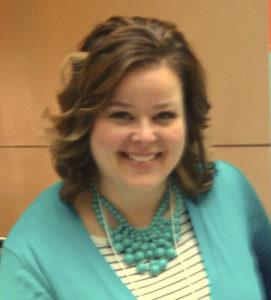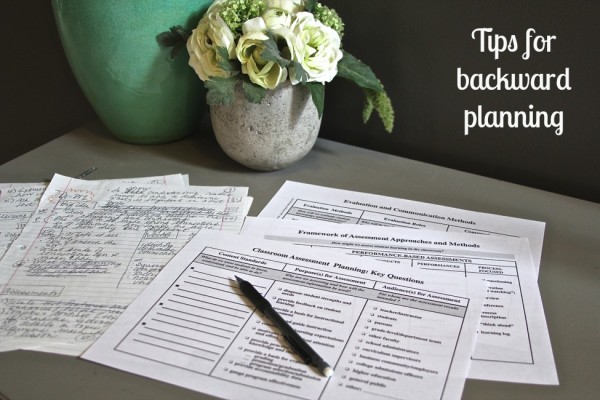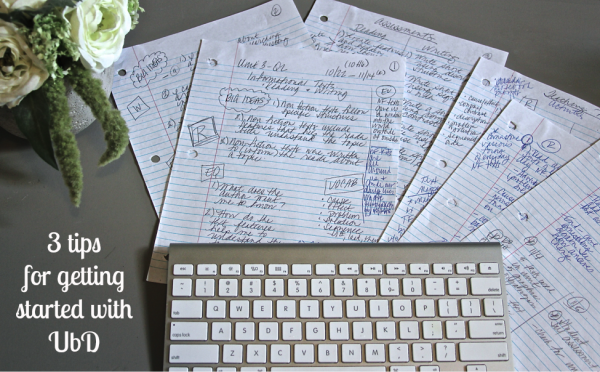
Understanding by Design (UbD) is a powerful but potentially daunting approach to planning curriculum. I’ve invited Jennifer Martinez, of everything just so, to share how she went from dreading UbD to allowing it to transform teaching and learning in her classroom. Jennifer, who’s from Columbus, Ohio, taught for nine years and spent a year writing curriculum for the NEA Master Teacher Project. She then decided to make the jump into designing curriculum full time. Updates on her resources for elementary teachers can be found through her blog, Teachers Pay Teachers store, and on Instagram. Thank you, Jennifer, for sharing your experiences with us!
Do you dread lesson planning? Tired of scrambling for ideas of what to teach at the last minute? Ever feel as if all those hours of hard work never really bring about results?
It’s time for UbD.

I learned of Understanding by Design (UbD) during my first teaching job at a school for dyslexic students. As a whole, it was an amazing environment for learning and growing as a teacher. Much of who I am as an educator and my beliefs about education were founded in that place. We were a population that valued best practices, remaining current in your field, and doing what was best for children.
Part of that culture meant trying new ideas. And I don’t mean jumping on bandwagons or testing out the latest trends, but incorporating methods and practices that had research and logic to support them. One of these was the Understanding by Design framework. As a faculty, we were introduced to the approach one Friday afternoon during a weekly PD session. We were given our own books, read through the introductory chapters, and then spent the remaining time practicing with partners. A few inservice hours later, we were required to submit all future units following this format.
I hated it. (Just keeping it real here, friends.) Many hours of frustration and tears followed that initial training. The entire idea of “backwards design” was just that – backwards to me. It went against everything I had learned in college and what I thought was the “normal” process of lesson planning. Believe me when I tell you, it was a real struggle to adapt this sort of thinking and make it my routine.
But, then something wonderful happened. My students began making connections between real life experiences and our lessons. They were thinking critically about content area topics and asking questions that led to more learning. Most of all, I could see a positive increase in their success on assessments – both formal and informal.
It was working.

What is UbD?
Understanding by Design is an approach to curriculum planning created by the late Grant Wiggins and Jay McTighe. In their words, “it is a way of thinking more purposefully and carefully about the nature of any design that has understanding as the goal.” Quite simply, it is the most efficient way I’ve found to create units that are not only meaningful, but also cohesive and effective.
There are two key ideas to Understanding by Design: understanding and design.
First, understanding. Foundationally, using the UbD approach forces you to decide what is most worth understanding about your content. What is it students really need to know here? But, it’s also about transfer. You want kids thinking globally rather than focusing locally. How can I teach students to think critically about a topic rather than thinking small? What big ideas can I teach my students about “x” that also apply to “y” and “z?”
This pertains not just to instruction, but also to assessment:
Do your assessments allow students to show true understanding?
Can they explain a concept using their own words?
Can they show you what they’ve learned in a way other than the one you’ve taught them?
Can they teach someone else?
There’s a great saying that is so true here – just because you know something doesn’t mean you understand it. I know that the sky is blue, but that doesn’t mean I can explain to you the science behind why. Students may be able to correctly answer 8 x 6 on a math test, but that doesn’t mean that they can also show you what 8 x 6 represents with a box of manipulatives or in a real life situation.
We must do more than teach rote facts or teach for coverage. We must teach for understanding, especially in this day of the CCSS where critical thinking is king. Students must understand the “how” and “why” behind each lesson so that they can use that knowledge and apply it to new experiences.
Why finding “engaging” activities is NOT effective planning
The second key idea is design. In many classrooms across the country, lesson planning looks much like this:
- Identify the content that needs to be covered
- Spend countless hours looking for activities on Pinterest and Teachers Pay Teachers that look fun and seem related
- Make a skeleton plan of when to use those activities over the coming week
- Repeat
You come to the end of a unit and hope that students are prepared and will perform well on a test. But, they don’t. You ask them about the content weeks after the test and they look at you like they have no idea what you’re talking about. And you can’t figure out why. After all, they were “engaged” in so many hands-on activities! Each one was related to the designated standards! Everyone seemed to enjoy the lessons! What happened?
Only in teaching does this type of planning exist. Think about it.
Have you ever taken a long trip? Ever played a team sport? How about set a lofty goal? How do you make each of those successful? You work backwards.
For any other task, you decide on an end point – go on a Caribbean cruise, make the all-stars team, lose twenty pounds – and then make your plan of how you will reach that goal. It all starts with the end in mind.
The 3 main stages to planning “backwards”
- Identify desired tesults. First decide what you want your students to be able to do, know, and understand when they reach the end of your unit. What is your end goal? What pieces of information should they take with them, what do you want them to be able to do, and what big ideas should they be able to transfer to other areas of life?
- Determine acceptable evidence. Next, decide how you will assess what they know. What types of evidence will serve as your proof that they truly have learned the content? This is more than just a final test. Think bigger and include all kinds of assessment – observation, discussions, exit tickets, journal writing, teaching a peer, etc. There should be several measures scattered throughout your unit to ensure understanding from beginning to end.
- Plan learning activities. This is where you go looking for those activities, materials, and resources. Now that you have a clear idea of what’s important and an end goal in mind, creating a learning plan is SO much easier! You won’t be tempted to fill each day with fluff – you know what I’m talking about. Those projects that look super cute on your favorite blogger’s Facebook page or the ones that look so appealing in the hallway outside your peer’s classroom door, but when truly examined have very little instructional value. Don’t get me wrong – I’m tempted to go there too sometimes! But, be strong! Fight the power! Be a teacher of meaning! Use activities and projects, but only choose those that are directly related to helping students successfully meet that end goal.
Top 3 reasons to use UbD
- You will see results. When you teach for understanding, students learn to think for themselves. Critical thinking comes naturally rather than a product of prompting. Students see connections between ideas and pursue them independently. (And, as a by-product, they’ll perform better on tests too!)
- It will save you time (and your sanity). No more wasting countless hours every weekend searching for ideas on what to teach next. No more scrambling for cute activities on Thursday night to use Friday morning. Commit to devoting a few hours at the beginning of each month to planning your next unit. Then, simply gather the specific resources you need each week to copy, laminate, etc. and you’re done!
- You’ll become a better teacher. You really have to know your stuff if you’re going to use this approach. Determining importance first requires you to know your topic well. Next, the design aspect asks you to plan with your students in mind. Teaching is no longer about the teacher, but about the students. Utilize what you know about your class in order to create a learning plan that ensures they’ll reach the end goal. You will be able to justify your lessons to anyone who asks, as there will always be a specific “why” behind what you’re teaching and “how” it benefits your students. No more fear of that dreaded admin walk through. Everything that happens in your classroom is meaningful and can be explained.
3 tips to get started with UbD
I admit, making the transition to this type of planning takes practice and time. At first, you will feel as if this is making lesson planning worse – not better. But, be patient! Just like anything else, there is a learning curve when mastering something new. Here are a few tips I wish I had followed when I first started:
- Go slow. Don’t do what I did (or was forced to do…) and try to use this framework for every lesson you create from here on out. Instead, start with one lesson or unit. Choose one that you know well and have taught many times before. Use the UbD tools simply to enhance and streamline your unit. Give yourself time to learn the process before tackling your remaining units.
- Be flexible. The Understanding by Design book and Jay McTighe’s website are full of templates and forms to use while planning. Use these as a guide or a resource rather than a rigid structure. They’re simply there to help you through the process and should not be considered the only way to plan. If you look at my process, it’s honestly quite a mess in the beginning! I have a blank template next to me, but do all of my work on notebook paper handwriting my ideas as I go. Eventually, that mess gets typed into a neat, organized plan, but for a while my notes make sense to no one but me. Allow yourself the same freedom!
- Get help. Don’t try to go it alone. Find a peer who’s ready to tackle understanding too. Even if it’s someone who doesn’t work in the same building – find a like-minded teacher who will work through the process with you. Having a buddy as a sounding board is always helpful.
Don’t have a buddy? No problem! I’ve collected several different resources to help you on my Understanding by Design Pinterest board. Here you will find articles, videos, links to example units, and schools who utilize the framework:

Angela Watson
Founder and Writer
Discussion
Leave a Reply
OR

Join our
community
of educators
If you are a teacher who is interested in contributing to the Truth for Teachers website, please click here for more information.

















Jennifer,
This reminds me of some good PD I did when the book first came out. We would share a high/med./low work sample and our “trusted colleagues” would try to figure out what the goal of our lesson(s) was and how we had designed it. There was a whole process that was really respectful and reflective. It might have come right from Jay. Your article just reminded me of that experience, and even though it was close to 15 years ago, it still impacts my own reflective process.
Miriam,
That sounds like a great exercise. It is important to be reflective, review student work, and see if the end result aligns with your goals. I always appreciate working with peers to gain different perspectives. Thanks for reading and for your comment!
Jennifer
This is a wonderful approach!
Could you please upload me with samples of ubd plans.thanx
Hi Jonah,
If you visit my UbD Pinterest board, you will find several links to sites that offer sample plans.
Thanks! Jennifer
I teach first grade and struggle to find things for primary planning. Will this still work for primary?
Hi Tracey,
Yes, absolutely! The backwards approach isn’t about a specific grade level or content area, rather it’s a way to structure your thinking about planning and instruction. So, yes that would be appropriate for any grade. Thanks for asking!
Transformed into a 5 hour lesson plan writing time. This is in addition to the 90 minute PLC. How do you carve out that extra 5 hours a week? It is 2:00 am on a Friday night and I JUST finished only next week’s LPs. Add that to the materials that I have to create, papers to grade, and teaching after school tutorials daily. I cannot remember what it was like to get to bed before 1am.
I’m sorry you’re struggling with this, Dawn! I know UbD can be time-consuming. I wonder if any of the info here would be helpful as you figure out how to streamline your lesson planning?
I am looking to begin planning for next year in an organized, and effective manner.